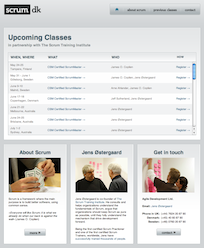Relaunching scrum.dk

About five weeks ago I launched a new version of scrum.dk. The site was rebuilt from the ground up using several bits and pieces of technology that I had wanted to try out for some time:
- Refinery CMS
- ThemeForest
- Heroku
Refinery CMS: There are currently three Rails based CMSs that I think are suitable for production use: Radiant, BrowserCMS and Refinery. Radiant is the grand-old man of Rails CMSs, but I never really fell in love with it. BrowserCMS looks like a really solid CMS with loads of features, especially features you would expect to find in commercial “enterprise” offerings. I find the interface to be quite complex, to the point where I think it will require training end users in its use, but I am sure it has its uses on larger CMS implementations. Refinery CMS is a fairly new Ruby on Rails CMS, that comes with a nice and clean interface and has the most basic functionality built-in, like image and file-upload.
ThemeForest: They have some great HTML templates, and this is now the first place I go to to find a template for a new project. Themes cost around $10-20 and the fact they charge for them, means you won’t see them on thousands of other sites.
Heroku: Probably the slickest Ruby cloud platform available today. Deployment basically comes down to pushing your code to a remote repository on Heroku. That’s it! Heroku is a fully managed platform, so you never see a shell prompt, and don’t need to worry about installing any part of the Ruby web stack.
Refinery, ThemeForest and Heroku turned out to be a really potent mixture. Refinery helped me get a few pages of content up really quick and allowed me to easily add some custom functionality. The ThemeForest template solved was it often the biggest obstacle for a design-challenged developer: Making the site look professional. Heroku made deployment the simplest thing in world. I could have deployed to an existing server of mine with minimal effort, but that would have left me with one more application to babysit. As long as you plan on deploying to Heroku from the beginning by using PostgreSQL for development, Amazon S3 for file storage and make sure any gems or plugins are compatible with Heroku, you should have no difficulties getting your application deployed to Heroku.
Trackbacks
Trackbacks are closed.
